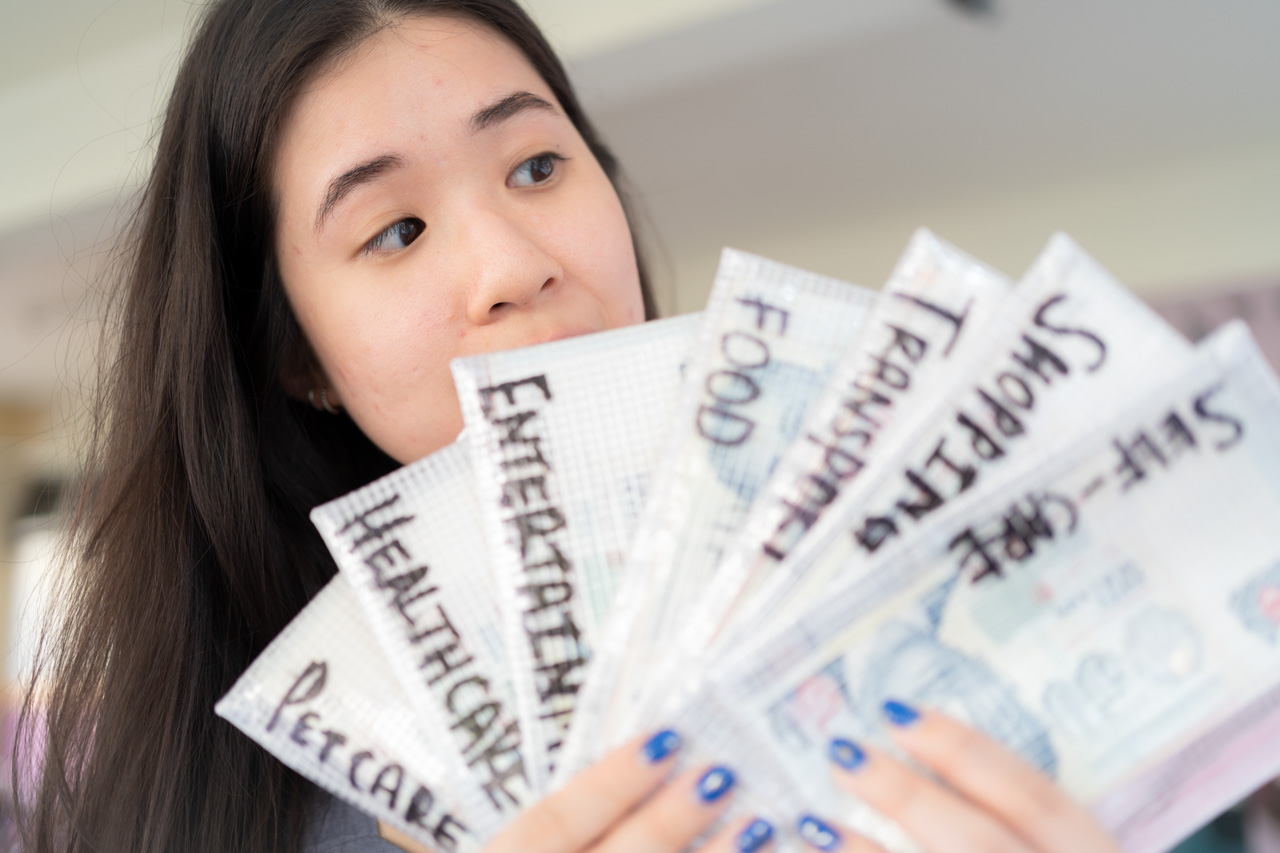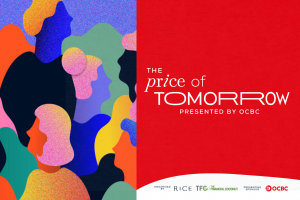Top image: Stephanie Lee for RICE Media
As someone who’s a year away from turning 30, there are (embarrassingly) many occasions where I still feel like a child. Budgeting is one of them.
My approach to personal finance thus far is simple: Try not to spend too much. As long as my bank balance sees a net increase at the end of the month, I’m good.
But this laissez-faire approach has left me with a very modest pool of savings—perhaps enough for a rainy day, but definitely not enough for sizeable expenses like a wedding or home renovations.
Hell, I haven’t even bought myself a life insurance plan—it’s been on the to-do list for the last few years—and I’ve been dodging calls from my financial advisor. In a nutshell, anything that’s finance-related and requires a modicum of research is too overwhelming and gets shafted for some other time when I’m not so busy (i.e. it never gets done).
I’ve always just assumed I’m bad with money. But I’ve recently discovered that my behaviour has a name: Money avoidance. It’s a coping mechanism stemming from financial anxiety, money coach Parween Mander tells Refinery29.
Humans naturally tend to avoid stressful situations. This fight-or-flight instinct protected our ancient ancestors from predators. But it now has people like me stuck in a cycle of unhealthy financial habits.
And what a cycle it is. My personal savings are inadequate enough to cause discomfort, to the point that I avoid budgeting. Which then worsens the situation and leads to further unease.
With peers my age collecting payouts from their fixed deposit plans and making their money work for them via ✨investments✨, there’s a niggling sense that I’m lagging behind. I haven’t done much about it, though. That’s the problem—cycles are hard to break out of.
Perhaps it was divine intervention that my editor issued me a month-long cash-stuffing challenge. He has no idea exactly how financially irresponsible I am, but the number of times I’ve Grabbed to the office might have clued him in.
Old Trend, New Name
What’s cash stuffing? In essence, it involves allocating your spending for the month into different categories and stuffing the cash into envelopes or folders.
It’s not new by any means. Older folks who used to keep their money in Milo tins under their bed probably did this. Before its recent resurgence on TikTok (as things are wont to do on the platform), it was called the envelope system.
The trend’s taken on a new life on TikTok, with creators sharing everything from their budget breakdown to how they decorate their cash envelopes.
No matter what you call it, the principle is the same. Seeing your money dwindle in real time will help you control your spending. And seeing the amount that you’re saving will reduce financial anxiety. Tangibility is key.
Plus, I’ll have a clearer idea of how much I’m actually spending each month. When I say I typically don’t track my spending, I’m not exaggerating. I have no idea how much I spend on things like food, shopping or entertainment in any given month. I do know that I spend $300 to $400 on ride-hailing each month because I was forced to tabulate it for an article.
My cash stuffing challenge spanned the month of May and kept to the following rules:
– All spending was to be in cash, except expenses that are generally constant from month to month like Netflix, phone bills, and EZ-Link usage. (Cash stuffing is typically used for variable expenses such as shopping and food.)
– The breakdown most cash stuffers usually adopt is 50 percent of income for needs, 30 percent for wants, and 20 percent for savings. However, I elected to save about a third of my income as I’m still living with my parents and don’t have big expenses like a mortgage or rent.
With my spending for the month withdrawn and stuffed into the requisite pouches, I was ready. At least, as ready as I’d ever be.
Week 1: Dealing in Cold, Hard Cash
Money spent: $241.75
I didn’t exactly announce the challenge to most of the people in my life, but they certainly noticed the mega wads of cash I was toting around.
The most common reaction I got was, “Why?”
It’s a reasonable question in cashless Singapore.
I hardly carry cash around. Most of my payments are made with a tap of my smartphone or via cashless platforms like PayNow. And it seems that a majority of Singapore does the same. Singapore’s cashless payment adoption rate is 97 percent (the highest in Southeast Asia) reports a 2023 Statista survey.
Even purchases that traditionally require cash, like vending machine snacks and hawker food, have cashless payment options these days.
As I embarked on my cash-stuffing challenge, I began to realise that I was practically the only person still using cash. At stores, cashiers would assume I was paying with PayWave and already had the credit card machine angled towards me, only to pause when they realised I was fumbling around in my bag for my cash.
Despite feeling like I was stuck in the past, paying with cash wasn’t all bad. Especially when I was shopping for an outfit for a friend’s wedding, the certainty of reaching for bills from a stuffed pouch felt markedly better than the usual quick tap of a phone and the accompanying wave of guilt.
Another lesson I quickly learned was to budget for emergencies. Right in the middle of Week 1, I had to make an urgent trip back to Malaysia for a relative’s funeral. Of course, I’d neglected to budget for this, so the $100 travel cost came out of my savings.
Week 2: Breaking the Avoidance Cycle
Money spent: $478.80
With cashless payments, budgeting fails, and unhealthy spending habits are easy to ignore. Some, for example, sweep their spending under the rug by not opening their banking apps, says an NPR article.
As I returned to Singapore and got into the full swing of cash stuffing, it soon became apparent that I couldn’t cut myself the same slack.
More budgeting fails peppered Week 2. This time, it was the red packet for the aforementioned friend’s wedding — another $150 came out of the savings pouch.
Cash-stuffing life removes the stress—and uncertainty—of day-to-day spending by essentially forcing you to delineate your budget at the start of each month.
I already knew I wasn’t the most organised when it came to my finances. But the exercise of mapping out my spending and discovering my oversights was the wake-up call I needed to be more cognisant of my money.
Spending cash was also forcing me to confront my ride-hailing habit. Seeing it dwindle from my Transport pouch each day was a reality check. Handing over my hard-earned cash to the drivers felt almost painful. So this was the amount I was spending each morning by choosing to sleep in instead of rising early to catch the train.
Week 3: Running Low on Funds… and Willpower
Money spent: $164.70
By this point, the novelty of the experiment had worn off with my friends, and they’d regarded me and my cash pouches with disdain.
“Don’t give me coins!” was the indignant response I got one afternoon while trying to pay a colleague back for lunch.
“Are you sure? It’s 70 cents.”
“Yes, yes. Keep it,” she grudgingly accepted the notes I’d scrouged together, waving off the coins in my other hand.
It wasn’t just the people around me. I discovered a number of cafes and restaurants had eschewed notes and coins completely, leaving me high and dry. Dining and dashing obviously wasn’t an option, so I ended up ‘cheating’ by using my credit card and taking the amount out of my Food envelope later on.
Maybe it was the hassle or my old avoidant patterns resurfacing, but I began to stay home more—just so I wouldn’t have to spend money. Sure, the pouches were gradually looking emptier. But that wasn’t the main motivating factor behind the sudden austerity. Digging out the cash for each transaction and tabulating my balance funds was a chore that I’d lost patience for.
I even skipped Grabbing a few times this week in favour of public transport—quite an out-of-character move.
Week 4: The Last Stretch
Money spent: $112.20
This challenge is really about budgeting, so it’s probably worth noting at this point that I was doing pretty well spending-wise. In order to keep within my spending limit, I’d made several money-saving decisions I was proud of this week, such as getting a kopi instead of a $9 latte.
There were, of course, some small miscalculations. I would end the experiment with some envelopes left mostly untouched, such as those for pet care, groceries, and healthcare. I’d basically allocated too much money to these categories, so they all went into the savings pool.
The good news was that I hadn’t run out of money in any category, and I’d managed to save a good 35 percent of my salary. While I did miss out on credit card spending perks such as cashback, I ended up saving more at the end of the day.
Having a tangible takeaway—an entire stack of cold, hard cash—was probably the most satisfying part of the challenge.
The bad news? I really hated using cash. Are the extra savings worth the trouble of carrying multiple envelopes around, annoying the people around me, and holding up the line at cashiers? I’m not sure.
The Aftermath: Rebound Spending
As much as I’d like to wrap things up with a neat bow and tell you I’ve suddenly grown a sense of financial responsibility, the truth is… I haven’t.
Like how people tend to rebound after strict diets, I was all too happy to treat myself to things I’d been resisting all of last month. The pure joy of being able to go back to cashless payments had me spending a little more than usual. I immediately went a little crazy at Sephora and The Editor’s Market, erasing my progress from last month.
That’s not to say that cash stuffing doesn’t work. It does. If someone with abysmal financial discipline like me can do it, anyone can. It’s just that the hassle of dealing with cash in a cashless nation is enough to make me think twice about fully committing to it.
Perhaps instead of fully relying on cash stuffing for all of my spending, a happy medium would be sticking to cash for my areas of weakness (ride-hailing and shopping) and going back to cashless payments for everything else.
For all its cons, though, I can see why the cash-stuffing trend is back in vogue. We might have progressed beyond the need for cash, but financial anxiety is a constant.
At a time when costs of living are high and only projected to rise further, extreme budgeting ain’t fun. We’re going to have to spend the cash anyway. Stuffing it into a pretty envelope makes the process just a little less painful.






